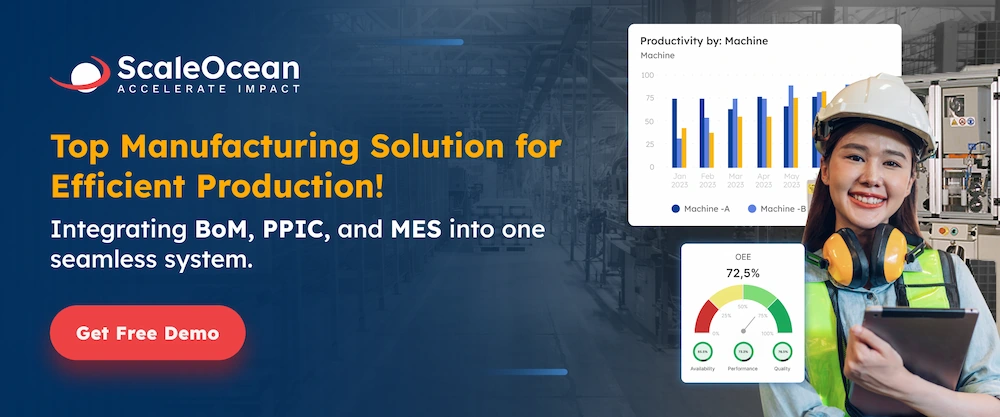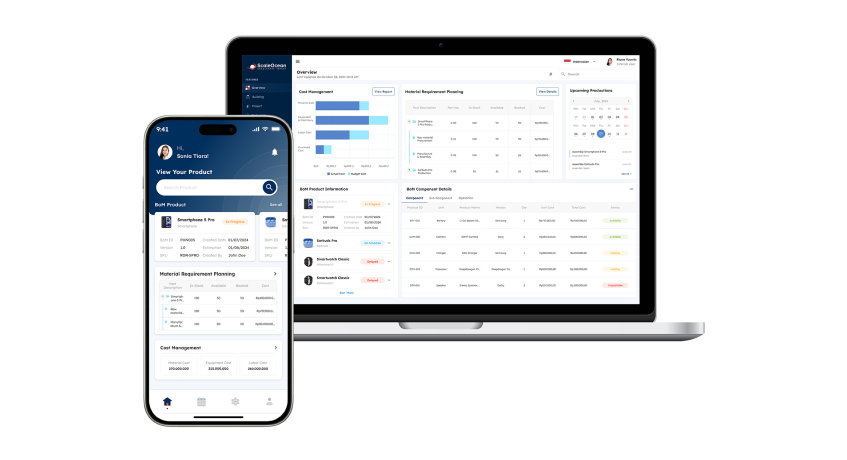Understanding manufacturing overhead is important for any company involved in production. While direct expenses such as raw materials and labor are easy to calculate, overhead costs are frequently overlooked, despite playing an important role in determining the true cost of goods.
Manufacturing overhead, often referred to as factory overhead or production overhead, encompasses the indirect expenses associated with the manufacturing process that cannot be directly linked to individual products. However, these costs are vital for the overall functioning of a manufacturing facility.
These costs cannot be directly attributed to any single product, but they are required for the production process to function properly. Calculating manufacturing overhead is essential for accurate pricing, budgeting, and profit. In this post, we will explain manufacturing overhead and walk you through the steps to accurately calculate it for your company.
- Manufacturing overhead encompasses the indirect expenses associated with the production process that cannot be directly linked to individual products.
- Examples of manufacturing overhead include: Rental costs for the factory, utility expenses, and property taxes, also depreciation, indirect materials, insurance.
- The importance of manufacturing overhead is establishing actual production costs, setting competitive prices, giving you choices of production methods, and improving your cost management.
- You can manage these costs automatically with scaleocean manufacturing software, which provides accurate calculations and analysis, and increases profitability by up to 50%.

What Is the Manufacturing Overhead?
Manufacturing overhead costs include all indirect costs associated with the production process, including utilities, rent, insurance, indirect labor, and materials. These costs are necessary to run a manufacturing plant, even though they are not directly related to the production of something specific. Understanding overhead cost manufacturing is crucial for effective budgeting and resource allocation in production facilities.
These manufacturing costs consist of direct labor costs, raw material costs, and overhead costs associated with production. Managing these costs effectively helps businesses maintain profitability and operational efficiency.
It is important to understand that manufacturing overhead costs also qualify as tax-deductible costs because they are considered essential to running a business and generating revenue. As a result, businesses are allowed to deduct the total amount of manufacturing overhead costs from their gross revenue, which reduces their taxable income and, in turn, the taxes they must pay.
Accurately calculating the true cost of production allows businesses to set competitive prices and make informed decisions about optimizing production processes and allocating resources effectively. Companies in Singapore can allocate overhead costs using manufacturing software or machine hours and labor hours to ensure accurate product pricing. Without proper overhead cost management, businesses can experience financial inefficiencies that affect their bottom line
Examples of Manufacturing Overhead
Manufacturing overhead costs include indirect costs associated with the production process that cannot be directly associated with a specific product. It is important to manage these costs as a function of operations. The following is an illustration of manufacturing overhead costs including:
- Rental costs for the factory, utility expenses, and property taxes: These are essential expenses for running the factory, covering the cost of using the building, maintaining utilities like water, electricity, and gas, and paying property taxes associated with the factory location.
- Depreciation on machinery and equipment: Over time, factory machinery and equipment lose value due to wear and tear. This depreciation is considered part of the manufacturing overhead, as it is a cost incurred to keep production equipment functioning.
- Compensation for factory management, maintenance staff, and quality assurance personnel: Salaries or wages paid to employees involved in overseeing and maintaining the factory operations are included in manufacturing overhead. This includes factory managers, maintenance workers, and quality assurance staff.
- Costs of indirect materials: These materials are used in the production process but are not part of the final product. Examples include cleaning agents, lubricants, and other consumables that support the production process but are not directly incorporated into the products.
- Insurance premiums and building upkeep expenses: The cost of insuring the factory and maintaining the building is another part of manufacturing overhead. This ensures the factory remains operational and covered against potential risks.
Also Read: What is Material Requirement Planning (MRP) and Its Benefits
The Importance of Managing Manufacturing Overhead
Understanding and accurately calculating manufacturing overhead costs is important for several reasons, as it helps businesses gain a clear picture of production costs and improve operational efficiency. Here are the reasons why managing overhead costs in the manufacturing process is important:
1. Establishing Actual Production Costs
By including overhead costs in the cost assessment, companies can ensure that they are considering all expenses related to production. This practice allows for effective financial planning and profitability evaluation.
2. Setting Competitive Prices
This allows a company to set a price for a product that covers all costs while remaining competitive in the market. Underestimating overhead costs can result in pricing a product too low, potentially resulting in financial losses. Conversely, overestimating these costs can result in pricing a product too high
3. Making the Right Choices Regarding Production Methods and Resource Allocation
Through the examination of manufacturing overhead, companies can pinpoint opportunities for cost reduction or optimization. This analysis aids in determining the most effective allocation of resources, which may include investing in advanced machinery, modifying workforce levels, or enhancing energy efficiency.
4. Improving Cost Management and Budgeting
By tracking manufacturing overhead, companies can detect variations or inefficiencies in their expenses over time. This allows them to establish more effective control strategies and predict future costs with greater precision, helping them remain within their budget and prevent unforeseen financial challenges.
What Is Included in Manufacturing Software?

Manufacturing overhead costs include indirect costs required to operate a production operation. These costs are useful in supporting industrial operations and establishing accurate prices, even though they are not directly related to the production of goods. Here are the major components of manufacturing overhead costs.
1. Facility Rent
Facility rent covers the cost of leasing or renting the manufacturing site. This cost is a fixed overhead expense that businesses must pay consistently, within all manufacturing levels, such as mass production. A carefully negotiated lease agreement enables manufacturers to manage costs effectively and maintain financial stability while securing an ideal location for production operations.
2. Utility Costs
Utility costs include power, gas, water, and waste disposal, which are required to keep production operations going properly. These expenses fluctuate based on operational intensity and seasonal variations. Monitoring and optimizing utility consumption through energy-efficient practices can help manufacturers reduce costs and improve sustainability.
3. Equipment Maintenance
Regular maintenance ensures that manufacturing machinery operates efficiently, reducing downtime and costly breakdowns. This includes scheduled maintenance, emergency repairs, and the replacement of worn-out components. Facility management software can help streamline these processes by organizing maintenance schedules and tracking repairs, ensuring that preventative maintenance procedures are followed to extend equipment life, increase productivity, and reduce unexpected production disruptions.
4. Asset Depreciation
Manufacturing equipment, buildings, and vehicles lose value over time as a result of wear and tear. Asset depreciation is an accounting charge that reflects this loss of value. Proper depreciation tracking helps manufacturers to make more informed decisions about equipment replacement, tax breaks, and long-term financial planning.
5. Workforce Expenses
Manufacturing overhead includes wages for factory staff who do not directly produce goods, such as supervisors, janitors, and maintenance personnel. These employees contribute to operational efficiency by ensuring smooth workflow, maintaining cleanliness, and supporting production teams. Managing labor costs effectively enhances productivity and cost control.
6. Operational Supplies
General-use items such as cleaning materials, lubricants, and protective gear fall under operational supplies. While not directly tied to specific products, these supplies are essential for maintaining a safe and efficient production environment. Monitoring supply usage and optimizing procurement strategies help reduce unnecessary spending.
7. Insurance Premiums
Manufacturing plants need insurance to cover risks like property damage, liability claims, and equipment breakdowns. Paying for insurance is a key overhead cost that protects business assets and ensures financial stability during unexpected events. Selecting the right insurance policies helps reduce risks and manage expenses.
8. Tax Obligations
Manufacturers must pay property taxes and other levies on their facilities and equipment. These tax obligations vary based on location and regulations. Proper tax planning and compliance help businesses avoid penalties, optimize financial strategies, and ensure uninterrupted operations while maintaining legal obligations.
9. Professional Fees
Legal, accounting, and consulting services required for business operations are all included in professional fees. These costs are necessary to ensure compliance with financial regulations, labor laws, and industry standards. Using qualified professionals allows manufacturers to streamline processes, reduce risks, and improve overall business efficiency.
Also Read: Top 8 Manufacturing Execution System in Singapore 2025
Manufacturing Overhead Formula
Manufacturing overhead is determined by summing all indirect expenses associated with the production process. By precisely identifying these costs, companies can achieve more accurate estimations and allocations of manufacturing expenses, leading to improved pricing strategies.
Here are the formulas and calculations that you can use:
Manufacturing Overhead = Indirect Materials + Indirect Labor + Other Overhead Costs
Indirect materials include supplies used in production but not part of the final product, such as lubricants and cleaning supplies. Indirect labor consists of wages for workers not directly involved in production, like supervisors and maintenance staff.
Other overhead costs encompass utilities, depreciation, rent, insurance, and factory maintenance. This formula helps businesses determine the total indirect costs necessary to run a manufacturing process efficiently.
How to Calculate Manufacturing Overhead
Manufacturing overhead is calculated by combining all indirect costs associated with the production process. It involves identifying all indirect costs associated with production, adding them up, and applying them to products based on a predetermined rate. This helps businesses understand the overall total cost of production.
Start by listing all indirect costs, which may include expenses like factory rent, utilities, equipment depreciation, maintenance, and indirect labor. Next, sum all these overhead expenses for a specific period, whether it’s monthly, quarterly, or annually.
Then, determine the allocation base to distribute the overhead costs, selecting from options such as labor hours, machine hours, or production units. After that, calculate the overhead rate using the formula below.
Overhead Rate =
Total Allocation Base / Total Manufacturing Overhead
For instance, if overhead costs are $50,000 and total labor hours are 10,000, the rate is $5 per labor hour. Lastly, multiply the overhead rate by the allocation base for each product to estimate its share of indirect costs.
The Types of Manufacturing Overhead Cost
Overhead costs are the silent driving force behind every business operation, often overlooked but essential to smooth functioning. There are several types of manufacturing overhead—fixed costs, variable costs, and semi-variable costs—that are essential for effective budgeting and cost control.
Let’s examine each category to uncover how they impact a business and why they matter, including:
1. Fixed overheads
This cost is consistent expenses that remain unchanged regardless of production volume, including costs such as rent, salaries, insurance, and depreciation of assets. For instance, a manufacturing facility incurs the same rental expense whether it produces 100 units or 1,000 units.
These costs are both predictable and stable, which facilitates budgeting; however, they can exert financial pressure during periods of reduced production. Efficient management is crucial for sustaining profitability, particularly in sectors characterized by varying demand.
2. Variable overheads
Variable overheads are costs that change with production levels, such as raw materials, utilities, packaging, and shipping. For example, a bakery uses more flour and electricity for 500 loaves than for 100.
While flexible, these costs can be challenging to manage during high production. Businesses must monitor them closely to avoid overspending and align expenses with output.
3. Semi-variable overheads
Semi-variable overheads consist of both fixed and variable expenses, featuring a stable base alongside a variable element that varies according to production levels or usage. For instance, a delivery service incurs fixed monthly maintenance costs while experiencing variable repair costs that depend on the distance traveled. Evaluating these expenses enables organizations to enhance their cost management and financial forecasting.
How Is Manufacturing Overhead Used?

Manufacturing overhead is important to cost management, pricing, and profitability. It includes indirect production costs such as rent, utilities, and maintenance, which ensure accurate financial reporting, cost allocation, and manufacturing efficiency. Here are how is manufacturing overhead used:
1. Cost Allocation for Accurate Pricing
Manufacturing overhead is distributed across products to determine their true production cost. This helps businesses set competitive yet profitable prices by ensuring all indirect costs are factored in. Without proper allocation, products may be underpriced or overpriced which affects overall profitability.
2. Financial Reporting and Compliance
Accurate tracking of manufacturing overhead is important for financial statements and tax compliance. Companies must report indirect costs correctly to meet accounting standards and regulatory requirements. Proper overhead accounting ensures transparency, helping businesses make informed financial decisions and avoid discrepancies in audits or financial evaluations.
3. Budgeting and Cost Control
Manufacturing overhead analysis helps businesses identify areas where costs can be reduced without impacting quality. By monitoring expenses like utilities, equipment depreciation, and maintenance, manufacturers can optimize their budgets, enhance efficiency, and allocate resources effectively to maximize profitability while keeping production costs under control.
4. Production Efficiency and Process Improvement
Tracking overhead costs helps identify inefficiencies in manufacturing operations. By analyzing these expenses, businesses can streamline processes, minimize waste, and optimize resource use throughout the product life cycle. For instance, elevated energy costs may highlight inefficient machinery, suggesting the need for energy-efficient equipment to reduce long-term production costs and enhance overall efficiency. This proactive approach ensures that businesses maintain cost-effective operations while improving productivity.
5. Decision-Making in Manufacturing Strategy
Manufacturing overhead data supports strategic decisions such as pricing changes, process automation, and facility expansions. Companies can use cost trends to decide whether to outsource production, invest in new technology, or optimize workforce planning. These insights ensure long-term growth and competitiveness in an ever-changing manufacturing landscape.

How to Reduce Your Manufacturing Overhead
Companies in Singapore must implement the right strategies to reduce production overhead costs can significantly increase efficiency and overall profits. By cutting unnecessary costs and optimizing the use of resources, you can lower their production costs. Here are some strategies to consider.
1. Optimize Manufacture Workflow
Streamlining operations involves optimizing production workflows to eliminate bottlenecks and enhance overall efficiency. By regularly assessing each stage of the process, companies can identify wasteful practices and areas of redundancy. Implementing automation and lean manufacturing principles can significantly reduce manual labor costs, improve product flow, and decrease delays, ultimately lowering overhead and boosting productivity.
2. Implement Regular Preventive Maintenance
Regular preventive maintenance is useful for reducing the possibility of equipment failures and costly repairs. Routine inspections and service allow potential faults to be recognized and treated before they become severe concerns. This proactive strategy not only extends the life of machines but also reduces downtime and manufacturing delays.
3. Repurpose Components from Existing Equipment
Repurposing components from existing equipment can help you save money on future purchases. Instead of discarding outdated parts, companies might discover innovative ways to repurpose them in other processes or equipment. This method minimizes waste, maximizes resource use, and improves overall efficiency, resulting in significant cost savings.
4. Employ an In-House Maintenance Specialist
Hiring an in-house maintenance specialist can reduce the dependency on external contractors. An internal expert can perform timely repairs and maintenance, ensuring that equipment remains in peak functioning order. This technique reduces downtime, improves reaction times, and provides greater control over maintenance plans and costs, ultimately improving cycle time and enhancing production efficiency.
5. Align Employees with Cost-Saving Objectives
Educating and aligning employees with cost-cutting objectives develops an efficient culture. Employees who understand the necessity of decreasing overhead expenses are more likely to help discover and implement cost-cutting solutions. Regular training sessions and workshops can help employees develop a cost-conscious mindset.
6. Strengthen Partnerships with Suppliers
Building strong partnerships with suppliers can lead to better pricing and more favorable terms. Businesses can save money and improve their cash flow management by negotiating bulk discounts and favorable payment arrangements. Maintaining good terms with suppliers also ensures a reliable supply chain and access to high-quality materials.
7. Minimize Dependency on Office Supplies
Reducing reliance on office supplies by going digital can lower overhead costs. Implementing electronic documentation and communication methods not only saves money but also enhances productivity and sustainability. Transitioning to a paperless environment reduces the need for physical storage and streamlines administrative processes.
8. Lease Out Unused Workspace
Leasing out unused space can help to generate revenue and offset overhead costs. Businesses can maximize space efficiency by utilizing underutilized areas within their facility. This strategy generates additional income while improving overall financial stability and resource management.
Track Manufacturing Costs with ScaleOcean Software

Efficient cost management is crucial for manufacturers to maintain profitability and competitiveness. ScaleOcean Manufacturing Software streamlines cost tracking with an integrated, data-driven approach that connects production and financial metrics. It provides real-time insights, ensuring every stage, from raw material procurement to final product costing, is closely monitored.
This enables businesses to identify cost-saving opportunities, optimize production, and minimize inefficiencies to stay competitive. Additionally, the software enhances forecasting and budgeting by leveraging accurate historical data and trends. ScaleOcean also offers free demos and consultations with team professionals for 100% optimal system implementation that suits your needs.
Features of ScaleOcean Manufacturing Software for Tracking Costs:
- Real-time Cost Monitoring: Track labor, material, and overhead costs in real time, providing instant insights into cost structures.
- Bill of Materials (BOM) Management: Link raw materials, components, and processes to calculate accurate manufacturing costs.
- Cost Variance Analysis: Compare budgeted vs. actual costs to pinpoint areas for cost control.
- Work Order Cost Tracking: Monitor the cost of individual work orders and batches to identify inefficiencies.
- Integration with Financial Systems: Integrate seamlessly with accounting systems for a unified view of financials and cost reporting.
ScaleOcean manufacturing software provides manufacturers with real-time, accurate data throughout the production lifecycle, allowing for better decision-making to reduce costs and increase profitability. Its comprehensive cost management tools account for all expenses, including materials, labor, and overhead.
Seamless integration with other business systems improves visibility and communication, thereby increasing operational efficiency. Furthermore, the software provides valuable insights into cost variances, helping manufacturers refine processes and minimize waste.
Conclusion
Manufacturing overhead is necessary for estimating genuine production costs, although it is frequently underestimated. Managing indirect expenses such as rent, utilities, and maintenance leads to more precise pricing, better planning, and increased profitability.
Proper tracking helps companies in properly allocating resources, enhancing output, and improving financial planning, all while eliminating inefficiencies that undermine competitiveness. With the right tools, overhead management becomes more efficient.
ScaleOcean Manufacturing Software offers real-time cost tracking, variance analysis, and financial integration, providing clear visibility into expenses. These insights help businesses refine processes, reduce waste, and boost profitability. Explore how ScaleOcean can support your manufacturing operations with a free demo and discover smarter ways to manage costs.
FAQ:
1. What are examples of manufacturing overhead costs?
Manufacturing overhead includes indirect costs like factory utilities (electricity, gas, water), equipment repairs, maintenance staff wages, and other expenses not directly tied to production efficiency but essential for operations.
2.What are examples of manufacturing costs?
Manufacturing costs consist of direct materials (e.g., wood in furniture, steel in cars), direct labor (wages for production workers), and factory overhead (indirect costs like utilities and maintenance).
3. What is the meaning of production overhead?
Production overhead, also called factory burden or manufacturing overhead, includes all indirect costs (e.g., utilities, maintenance, supervision) incurred during production. These are added to direct labor and material costs to determine the total cost of finished goods.
4. What is factory overhead with an example?
Factory overhead includes indirect costs like utilities (electricity, water, gas), maintenance, and rent. For example, electricity to power machinery is an overhead cost. Businesses may reduce these by negotiating long-term supplier deals.







 PTE LTD..png)
.png)

.png)








.png)
.png)
















